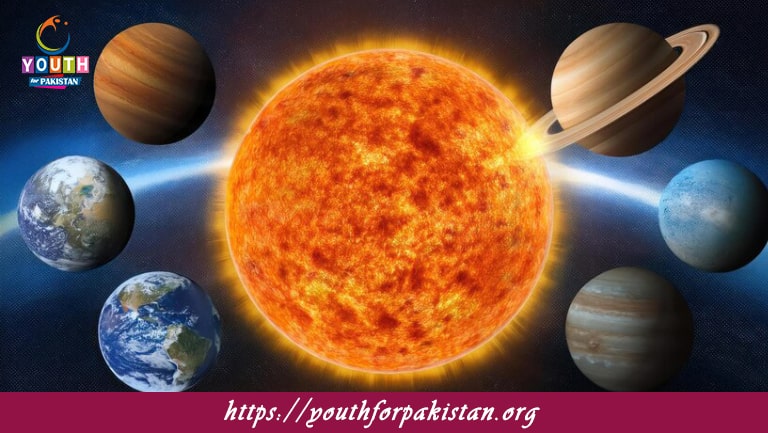Welcome to the Solar System and Celestial Bodies MCQs with Answers. In this post, we are sharing Solar System and Celestial Bodies Multiple Choice Questions and Answers in Everyday Science section for various competitive exams in Pakistan. Each question offers a chance to enhance your knowledge regarding Solar System and Celestial Bodies online MCQs Test.
Which planet is the largest in our solar system?
a) Earth
b) Saturn
c) Jupiter
d) Neptune
Which planet is known as the “Red Planet”?
a) Mercury
b) Venus
c) Mars
d) Jupiter
What is the primary composition of the Sun?
a) Hydrogen and helium
b) Carbon and oxygen
c) Iron and nickel
d) Silicon and sulfur
What is the term for a small rocky body orbiting the Sun, primarily found between Mars and Jupiter?
a) Comet
b) Asteroid
c) Meteor
d) Moon
Which planet has the most extensive ring system?
a) Uranus
b) Neptune
c) Saturn
d) Jupiter
Which planet in the solar system has the shortest day, rotating once every 10 hours?
a) Earth
b) Mars
c) Jupiter
d) Venus
Which of the following is not classified as a planet anymore?
a) Neptune
b) Venus
c) Pluto
d) Uranus
What is the name of the dwarf planet located in the Kuiper Belt?
a) Eris
b) Ganymede
c) Io
d) Triton
Which planet has the Great Red Spot, a giant storm larger than Earth?
a) Jupiter
b) Saturn
c) Uranus
d) Mars
Which is the smallest planet in our solar system?
a) Mars
b) Mercury
c) Venus
d) Earth
What is the hottest planet in the solar system?
a) Venus
b) Mercury
c) Mars
d) Earth
What is the only natural satellite of Earth?
a) Europa
b) Ganymede
c) Moon
d) Titan
What is the term for the boundary where the Sun’s influence ends and interstellar space begins?
a) Heliosphere
b) Magnetosphere
c) Exosphere
d) Heliopause
Which planet rotates in the opposite direction to most planets?
a) Uranus
b) Mars
c) Venus
d) Neptune
Which planet is known for its extreme axial tilt, causing unusual seasons?
a) Jupiter
b) Uranus
c) Neptune
d) Saturn
Which planet is closest to the Sun?
a) Mercury
b) Venus
c) Earth
d) Mars
What is a comet primarily composed of?
a) Gas and dust
b) Rock and ice
c) Metal
d) Plasma
What is the name of the largest volcano in the solar system, located on Mars?
a) Mauna Loa
b) Mount Everest
c) Olympus Mons
d) Kilauea
Which moon of Jupiter is thought to have a subsurface ocean?
a) Io
b) Europa
c) Ganymede
d) Callisto
Which of the following is the farthest planet from the Sun?
a) Uranus
b) Neptune
c) Saturn
d) Pluto
What is the name of the spacecraft that carried humans to the Moon?
a) Voyager
b) Apollo
c) Discovery
d) Enterprise
Which planet is often referred to as Earth’s “sister planet” due to its similar size and composition?
a) Venus
b) Mars
c) Mercury
d) Jupiter
What is the name of the largest moon in the solar system?
a) Titan
b) Ganymede
c) Europa
d) Callisto
Which planet has a day longer than its year?
a) Mars
b) Venus
c) Mercury
d) Saturn
Which planet has the fastest winds in the solar system, reaching speeds of over 1,200 mph?
a) Uranus
b) Neptune
c) Saturn
d) Jupiter
What celestial body is the largest object in the asteroid belt?
a) Ceres
b) Vesta
c) Pallas
d) Hygiea
Which planet’s atmosphere contains a large amount of sulfuric acid?
a) Earth
b) Mars
c) Venus
d) Saturn
What is the name of the boundary where solar wind pressure balances with interstellar wind?
a) Kuiper Belt
b) Asteroid Belt
c) Heliosheath
d) Oort Cloud
Which is the most massive planet in our solar system?
a) Jupiter
b) Saturn
c) Uranus
d) Neptune
What is the name of the first artificial satellite sent into space by humans?
a) Apollo 11
b) Sputnik 1
c) Voyager 1
d) Hubble
Which planet has a surface temperature hot enough to melt lead?
a) Venus
b) Mercury
c) Mars
d) Earth
What is the name of the largest known dwarf planet?
a) Pluto
b) Eris
c) Haumea
d) Ceres
Which celestial body in our solar system has the largest mountain?
a) Earth
b) Mars
c) Venus
d) Mercury
What is the primary factor that determines whether a celestial body is classified as a planet?
a) It must have a moon
b) It must orbit the Sun and clear its orbit of other objects
c) It must be spherical
d) It must have an atmosphere
What is the name of the boundary of the solar system beyond which objects are no longer gravitationally bound to the Sun?
a) Kuiper Belt
b) Oort Cloud
c) Asteroid Belt
d) Heliopause
Which planet has a moon called Titan, the only moon known to have a dense atmosphere?
a) Earth
b) Jupiter
c) Saturn
d) Uranus
What is the name of the region of space where long-period comets are thought to originate?
a) Asteroid Belt
b) Kuiper Belt
c) Oort Cloud
d) Heliopause
Which planet has the largest number of moons?
a) Jupiter
b) Saturn
c) Uranus
d) Neptune
What are the icy bodies that develop tails when they approach the Sun called?
a) Meteors
b) Comets
c) Asteroids
d) Planetesimals
If you are interested to enhance your knowledge regarding Physics, Chemistry, Computer, and Biology please click on the link of each category, you will be redirected to dedicated website for each category.








